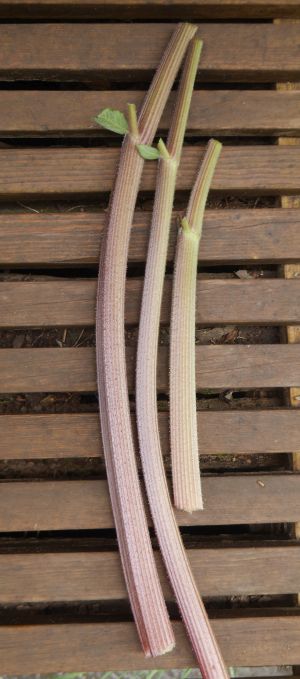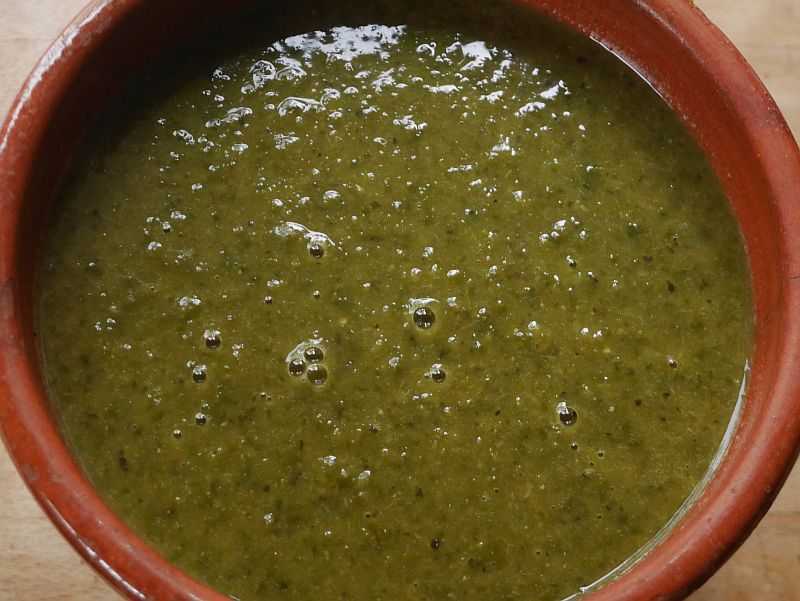This week’s perennial veg stir-fry with soba (buckwheat noodles), Japanese style contained the following (roughly left to right in the picture):
Nettles / stornesle (Urtica dioica)
Burdock / storborre roots (Arctium lappa); stored in the cellar
Wapato tubers (Sagittaria latifolia); stored in the cellar in water
Ramsons / ramsløk (Allium ursinum)
Caucasian spinach / stjernemelde (Hablitzia tamnoides)
Giant bellflower / storklokke (Campanula latifolia)
Himalayan water creeper (Houttuynia cordata) – reddish shoots
Sand leek / bendelløk (Allium scorodoprasum)
Garlic / hvitløk (Allium sativum)

Tag Archives: Campanula latifolia
Bitter baccalao: roots and greens
No, I’m not vegan and have never been, I’ve been lactovegetarian with the occasional wild fish over 40 years. We always have some Norwegian dried cod (baccalao) at the ready in our cool larder. The usual way to make the dish baccalao here is to hydrate the fish for a couple of days and then layer potatoes, bulb onions, fish, tomatoes, garlic with olive oil, pepper and chili in large saucepan. I’ve always added seasonal greens too and often use green onions of various types instead of bulb onion.
Last night, we used the last of the potatoes from the cellar and as there weren’t many also used root chicory (di Sancino: an edible rooted variety that produces well here) and the last yacon roots, all still in perfect condition kept in the cellar in dryish leaves all winter! We also used a good bunch of nettles, tops of giant bellflower (Campanula latifolia) and sweet cicely (Myrrhis odorata) tops including the flowers. For the onions, sand leek (Allium scorodoprasum) and victory onion (Allium victorialis) were in perfect condition (beginning to flower).
The verdict on our first bitter baccalao? Delicious, but probably not for everyone!
Early June Greens and Whites
Presenting some of this week’s perennial greens and, in the case of the blanched Hosta shoots, perennial whites!
Hosta sieboldiana with ramsons / ramsløk (Allium ursinum) and giant bellflower / storklokke (Campanula latifolia)

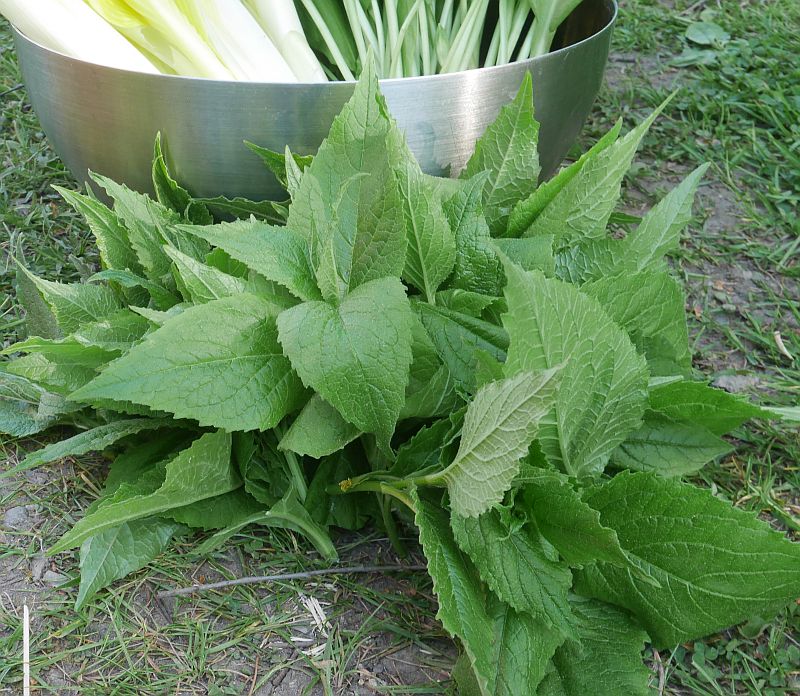
Today’s permaveggies
Presenting the 14 permaveggies used in tonight’s Indian dal!
Here are the ingredients:
Around the outside:
Blanched sea kale / strandkål (Crambe maritima)
Stinging nettle / brennesle (Urtica dioica)
Top left and anti-clockwise:
Caucasian spinach / stjernemelde (Hablitzia tamnoides)
Hedge garlic / løkurt (Alliaria petiolata)
Cow parsnip (Heracleum lanatum)
Day lily / daglije (Hemerocallis shoots)
Common wintercress / vinterkarse (Barbarea vulgaris)
Giant bellflower / storklokke (Campanula latifolia)
Blanched lovage / løpstikke (Levisticum officinale)
Ground elder / skvallerkål (Aegopodium podograria)
Victory onion / seiersløk from the Lofoten Islands in Norway (Allium victorialis)
In the middle:
Great waterleaf (Hydrophyllum appendiculatum) grows well in my garden and self-sows. It’s natural habitat is damp calcareous woodlands in Eastern North America.
Patience dock / hagesyre (Rumex patientia)
Afterthought:
Moss-leaved dandelion / mosebladet løvetann (Taraxacum sublaciniosum “Delikatess”) – one entire leaf rosette with dandichokes and top of the roots)
Forced March Perennial Greens
In order to lengthen the season for harvesting of perennial vegetables, I dig up roots of a selection in the autumn and plant them in garden soil in large buckets (which I have a surplus of through my Allium project, now moved to the botanical gardens). As I explain in the video, all of these can be stored outside exposed to the cold as they are very hardy (minimum about -20C here), but some get a head start by moving into my cold cellar where they start growing slowly in the dark. Welcome to my living room:
These were the forced veggies used one day last week, from top left and across – Heracleum sibiricum (hogweed / bjørnekjeks); Campanula latifolia (giant bellflower / storklokke); Myrrhis odorata (sweet cicely / spansk kjørvel); Taraxacum officinale (dandelion / løvetann); (bottom row): Allium angulosum; Ficaria verna (lesser celandine / vårkål); Allium flavescens and Armoracia rusticana (horseradish / pepperrot); (centre right): wild buckwheat / vill bokhvete shoots – Fagopyrum tataricum)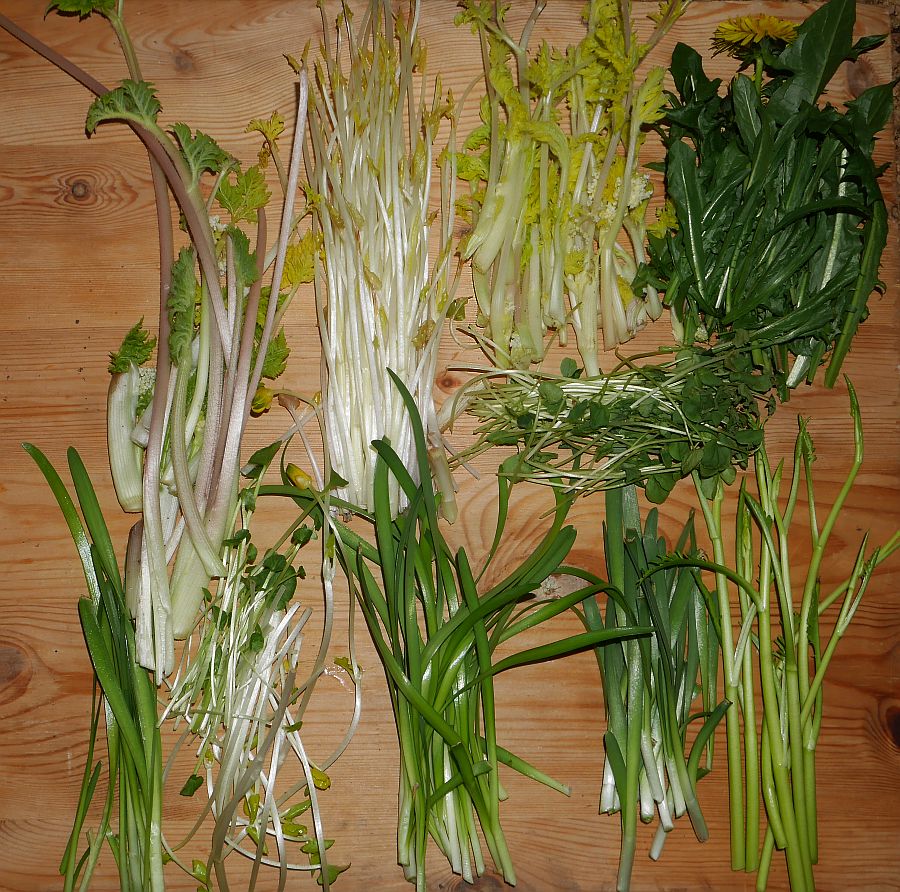
Nettle-leaved bellflower
Nettle-leaved bellflower (Campanula trachelium) has a more southwesterly distribution in Europe than my favourite giant bellflower C. latifolia and replaces the latter species in the south of England, France, Italy, Spain and North Africa and eastwards into West Asia. It has also widely naturalised in northeast North America. Like C. latifolia, it has edible sweetish tasting roots that contain the carbohydrate inulin like Jerusalem artichoke, good for diabetics, but can give flatulence. I suspect, however, that it takes several years to get to a usable size. I’ve been digging over an area of the garden into which Polygonum alpinum (Alpine knotweed) had invaded this week and there were also many self-seeded bellflowers with good sized roots, so I put them to one side to use in a delicious zucchini-bellflower curry which we ate last night!

Nettle-leaved bellflower has similar habitat requirements to the giant bellflower, inhabiting open woodlands and hedgerows and grows well in complete shade on the north side of my house amongst the Hostas. It has a preference for alkaline soils and grows well on clay. It is therefore an excellent plant for the forest garden, although given the choice I would prefer the giant bellflower as the spring leaves of trachelium are coarser and hairier and therefore less good in salads, but nevertheless fine finely chopped in mixed salads. It has been used traditionally in Italy in mixed species spring soups such as minestrella (see page 59) and is one of the ingredients in pistic (boiled and fried, see page 59 of my book Around the World in 80 plants).



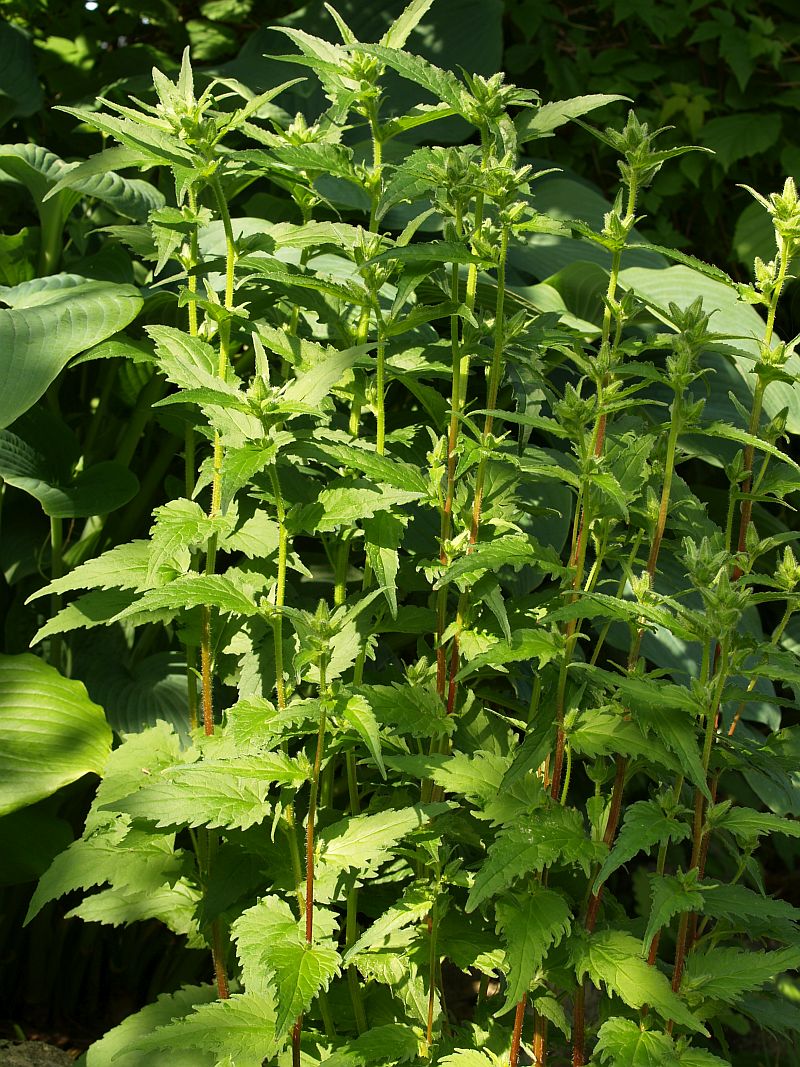
There are a number of ornamental forms available in the trade which you might like to try, including a single-flowered white form (var. alba), which has naturalized in my garden. The double white (‘Alba Flore Pleno’) form and “Snowball” (https://dorsetperennials.co.uk/product/campanula-trachelium-snowball) haven’t come true from seed for me. ‘Bernice’ is another deep purple-blue flowered cultivar.




Norwegian quinoa and swamp greens medley
13th June 2020 perennial greens were stir-fried and served with quinoa and served with Allium ursinum flowers.
Allium validum (swamp or Pacific onion) with flower shoot
Saxifraga pensylvanica (swamp saxifrage)
Gunnera tinctoria
Asparagus officinalis (asparges)
Crambe maritima (sea kale / strandkål broccolis)
Perennial kale “Walsall Allotments” (flerårig kål)
Campanula latifolia (giant bellflower / storklokke)
Aster macrophyllus (big-leaf aster)
flowering shoots of various Russian Rumex acetosa cultivars (sorrel / engsyre)
The greens were stir-fried with chili and garlic and served with Norwegian organic quinoa with ramsons (ramsløk) flowers:


Garden wild green soup
Last night we made a green pea soup and apart from the Hablitzia (Caucasian spinach / stjernemelde), I used perennial vegetables growing in a wild part of the garden. With little or no help from me there’s a bounty of wild edibles in this area under wild hazels (Corylus avellana) and this made for a delicious pea soup with masses of greens.
Campanula latifolia is documented as used in spring soups in the 16th century in my area in Norway and Heracleum shoots are also a tradional soup ingredient, in particular Russian borsch now thought of as a beetroot soup was originally made with hogweed shoots.
Wild domesticated edibles and 65 habby days
Tonight’s omelette had more or less only wild edible perennial plants from my area in it, although all grow in my garden, managed in some way…with one exception which has been in every evening meal for 65 days now, the first in this list:
Hablitzia tamnoides (Caucasian spinach / stjernemelde)
Taraxacum officinale (dandleion / løvetann)
Allium ursinum (ramsons / ramsløk)
Campanula latifolia (giant bellflower / storklokke)
Alchemilla spp. (lady’s mantle / marikåpe)
Urtica dioica (stinging nettle / brennesle)
Aegopodium podograria (ground elder / skvallerkål)

Quinoa greens
Tonight’s 22 greens from the garden with yacon used in a quinoa stir-fry (with garlic and chili in addition):
Brassica oleracea (perennial kale / flerårig kål)
Hydrophyllum virginianum (waterleaf, indian salad)
Tragopogon pratensis (Jack-go-to-bed-at-noon / geitskjegg)
Angelica spp. (kvann)
Allium carinatum
Allium ursinum (ramsons / ramsløk)
Primula elatior (oxlip / hagenøkleblom)
Hablitzia tamnoides (Caucasian spinach / stjernemelde)
Carum carvi (caraway / karve)
Myrrhis odorata (sweet cicely / spansk kjørvel)
Polymnia edulis (yacon)
Urtica dioica ( stinging nettle / brennesle)
Campanula latifolia (giant bellflower / storklokke)
Ficaria verna (lesser celandine / vårkål)
Rumex acetosa (sorrel / engsyre)
Dystaenia takesimana (giant Ulleung celery)
Hemerocallis spp. (day lily / daglilje)
Taraxacum spp. (dandelion / løvetann)
Rheum ribes
Armoracia rusticana (horseradish / pepperrot)
Allium nutans
Aegopodium podograria (ground elder / skvallerkål)
























